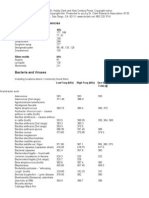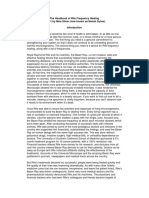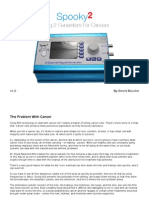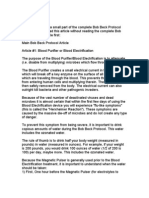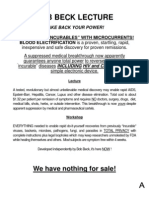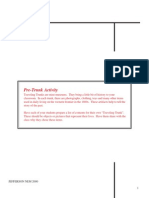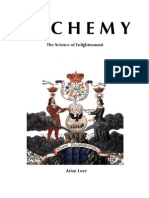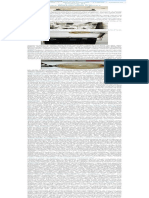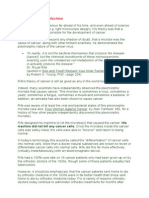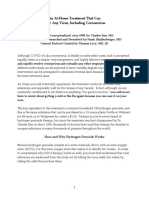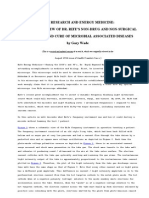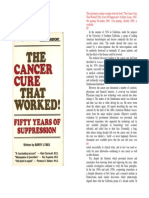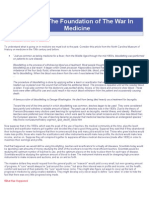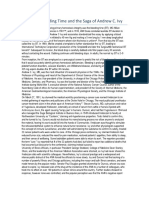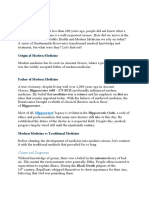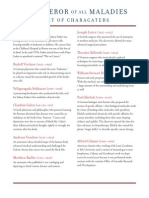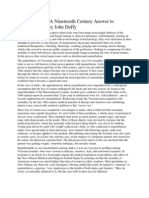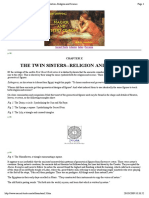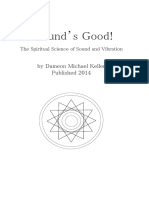The Cancer Cure That Worked PDF
The Cancer Cure That Worked PDF
Uploaded by
corbu_georgeCopyright:
Available Formats
The Cancer Cure That Worked PDF
The Cancer Cure That Worked PDF
Uploaded by
corbu_georgeCopyright
Available Formats
Share this document
Did you find this document useful?
Is this content inappropriate?
Copyright:
Available Formats
The Cancer Cure That Worked PDF
The Cancer Cure That Worked PDF
Uploaded by
corbu_georgeCopyright:
Available Formats
Royal Raymond Rife and the Cancer Cure That Worked!
Barry Lynes
In the summer of 1934 in California, under the auspices of the University of Southern California, a group of leading American bacteriologists and doctors conducted one of the first successful cancer clinics. The results showed that: a) cancer was caused by a micro-organism; b) the micro-organism could be painlessly destroyed in terminally ill cancer patients; and c) the effects of the disease could be reversed. The technical discovery leading to the cancer cure had been described in Science magazine in 1931. In the decade following the 1934 clinical success, the technology and the subsequent, successful treatment of cancer patients was discussed at medical conferences, published in a medical journal, cautiously but professionally reported in a major newspaper, and technically explained in an annual report of the Smithsonian Institution. However, the cancer cure threatened a number of scientists, physicians, and financial interests. A cover-up was initiated. Physicians using the new technology were coerced into abandoning it. The author of the Smithsonian article was followed and then was shot at while driving his car. He never wrote about the subject again. All reports describing the cure were censored by the head of the AMA (American Medical Association) from the major medical journals. Objective scientific evaluation by government laboratories was prevented. And renowned researchers who supported the technology and its new scientific principles in bacteriology were scorned, ridiculed, and called liars to their faces. Eventually, a long, dark silence lasting decades fell over the cancer cure. In time, the cure was labeled a "myth"it had never happened. However, documents now available prove that the cure did exist, was tested successfully in clinical
126
The Suppression of Alternative Medical Therapies
127
trials, and in fact was used secretly for years afterwardscontinuing to cure cancer as well as other diseases. BACTERIA AND VIRUSES In nineteenth-century France, two giants of science collided. One of them is now world-renownedLouis Pasteur. The other, from whom Pasteur stole many of his best ideas, is now essentially forgottenPierre Bechamp. One of the many areas in which Pasteur and Bechamp argued concerned what is today known as pleomorphismthe occurrence of more than one distinct form of an organism in a single life cycle. Bechamp contended that bacteria could change forms. A rod-shaped bacterium could become a spheroid, etc. Pasteur disagreed. In 1914, Madame Victor Henri of the Pasteur Institute confirmed that Bechamp was correct and Pasteur was wrong. But Bechamp went much further in his argument for pleomorphism. He contended that bacteria could "devolve" into smaller, unseen forms what he called microzyma. In other words, Bechamp developedon the basis of a lifetime of researcha theory that micro-organisms could change their essential size as well as their shape, depending on the state of health of the organism in which the micro-organism lived. This directly contradicted what orthodox medical authorities have believed for most of the twentieth century. Laboratory research in recent years has provided confirmation for Bechamp's idea. This seemingly esoteric scientific squabble had ramifications far beyond academic institutions. The denial of pleomorphism was one of the cornerstones of twentieth century medical research and cancer treatment. An early twentieth century acceptance of pleomorphism might have prevented millions of Americans from suffering and dying of cancer. In a paper presented to the New York Academy of Sciences in 1969, Dr. Virginia Livingston and Dr. Eleanor Alexander-Jackson declared that a single cancer micro-organism exists. They said that the reason the army of cancer researchers couldn't find it was because it changed form. Livingston and Alexander-Jackson asserted:
The organism has remained an unclassified mystery, due in part to its remarkable pleomorphism and its simulation of other micro-organisms. Its various phases may resemble viruses, micrococci, diptheroids, bacilli, and fungi.
THE AMERICAN MEDICAL ASSOCIATION
The American Medical Association was formed in 1846 but it wasn't until 1901 that a reorganisation enabled it to gain power over how medicine was practised throughout America. By becoming a confederation of state
128
Suppressed Inventions and Other Discoveries
medical associations and forcing doctors who wanted to belong to their county medical society to join the state association, the AMA soon increased its membership to include a majority of physicians. Then, by accrediting medical schools, it began determining the standards and practises of doctors. Those who refused to conform lost their licence to practise medicine. Morris Fishbein was the virtual dictator of the AMA from the mid-1920s until he was ousted on June 6,1949 at the AMA convention in Atlantic City. But even after he was forced from his position of power because of a revolt from several state delegations of doctors, the policies he had set in motion continued on for many years. He died in the early 1970s. A few years after the funding of his successful cancer clinic of 1934, Dr. R. T. Hamer, who did not participate in the clinic, began to use the procedure in Southern California. According to Benjamin Cullen, who observed the entire development of the cancer cure from idea to implementation, Fishbein found out and tried to "buy in." When he was turned down, Fishbein unleashed the AMA to destroy the cancer cure. Cullen recalled:
Dr. Hamer ran an average of forty cases a day through his place. He had to hire two operators. He trained them and watched them very closely. The case histories were mounting very fast. Among them was this old man from Chicago. He had a malignancy all around his face and neck. It was a gory mass. Just terrible. Just a red gory mass. It had taken over all around his face. It had taken off one eyelid at the bottom of the eye. It had taken off the bottom of the lower lobe of the ear and had also gone into the cheek area, nose and chin. He was a sight to behold. But in six months all that was left was a little black spot on the side of his face and the condition of that was such that it was about to fall off. Now that man was 82 years of age. I never saw anything like it. The delight of having a lovely clean skin again, just like a baby's skin. Well, he went back to Chicago. Naturally he couldn't keep still and Fishbein heard about it. Fishbein called him in and the old man was kind of reticent about telling him. So Fishbein wined and dined him and finally learned about his cancer treatment by Dr. Hamer in the San Diego clinic. Soon a man from Los Angeles came down. He had several meetings with us. Finally he took us out to dinner and broached the subject about buying it. Well, we wouldn't do it. The renown was spreading and we weren't even advertising. But of course what did it was the case histories of Dr. Hamer. He said that this was the most marvelous development of the age. His case histories were absolutely wonderful. Fishbein bribed a partner in the company. With the result we were kicked into court for operating without a license. I was broke after a year.
The Suppression of Alternative Medical Therapies
129
In 1939, under pressure from the local medical society, Dr. R. T. Hamer abandoned the cure. He is not one of the heroes of this story. Thus, within the few, short years from 1934 to 1939, the cure for cancer was clinically demonstrated and expanded into curing other diseases on a daily basis by other doctors, and then terminated when Morris Fishbein of the AMA was not allowed to "buy in." It was a practise he had developed into a cold art, but never again would such a single mercenary deed doom millions of Americans to premature, ugly deaths. It was the AMA's most shameful hour. Another major institution which "staked its claim" in the virgin territory of cancer research in the 1930-1950 period was Memorial SloanKettering Cancer Center in New York. Established in 1884 as the first cancer hospital in America, Memorial Sloan-Kettering from 1940 to the mid1950s was the centre of drug testing for the largest pharmaceutical companies. Cornelius P. Rhoads, who had spent the 1930s at the Rockefeller Institute, became the director at Memorial Sloan-Kettering in 1939. He remained in that position until his death in 1959. Rhoads was the head of the chemical warfare service from 1943-1945, and afterwards became the nation's premier advocate of chemotherapy. It was Dr. Rhoads who prevented Dr. Irene Diller from announcing the discovery of the cancer micro-organism to the New York Academy of Sciences in 1950. It also was Dr. Rhoads who arranged for the funds for Dr. Caspe's New Jersey laboratory to be cancelled after she announced the same discovery in Rome in 1953. An IRS investigation, instigated by an unidentified, powerful New York cancer authority, added to her misery, and the laboratory was closed. Thus the major players on the cancer field are the doctors, the private research institutions, the pharmaceutical companies, the American Cancer Society, and also the U.S. government through the National Cancer Institute (organizing research) and the Food and Drug Administration (the dreaded FDA which keeps the outsiders on the defensive through raids, legal harassment, and expensive testing procedures).
THE MAN WHO FOUND THE CURE FOR CANCER
In 1913, a man with a love for machines and a scientific curiosity, arrived in San Diego after driving across the country from New York. He had been born in Elkhorn, Nebraska, was 25 years old, and very happily married. He was about to start a new life and open the way to a science of health which will be honored far into the future. His name was Royal Raymond Rife. Close friends, who loved his gentleness and humility while being awed by his genius, called h i m Roy.
130
Suppressed Inventions and Other Discoveries
Royal R. Rife was fascinated by bacteriology, microscopes and electronics. For the next seven years (including a mysterious period in the Navy during World War I in which he travelled to Europe to investigate foreign laboratories for the U.S. government), he thought about and experimented in a variety of fields as well as mastered the mechanical skills necessary to build instruments such as the world had never imagined. By the late 1920s, the first phase of his work was completed. He had built his first microscope, one that broke the existing principles, and he had constructed instruments which enabled him to electronically destroy specific pathological micro-organisms. Rife believed that the minuteness of the viruses made it impossible to stain them with the existing acid or aniline dye stains. He'd have to find another way. Somewhere along the way, he made an intuitive leap often associated with the greatest scientific discoveries. He conceived first the idea and then the method of staining the virus with light. He began building a microscope which would enable a frequency of light to coordinate with the chemical constituents of the particle or micro-organism under observation. Rife's second microscope was finished in 1929. In an article which appeared in The Los Angeles Times Magazine on December 27, 1931, the existence of the light-staining method was reported to the public:
Bacilli may thus be studied by their light, exactly as astronomers study moons, suns, and stars by the light which comes from them through telescopes. The bacilli studied are living ones, not corpses killed by stains.
Throughout most of this period, Rife also had been seeking a way to identify and then destroy the micro-organism which caused cancer. His cancer research began in 1922. It would take him until 1932 to isolate the responsible micro-organism which he later named simply the "BX virus." THE EARLY 1930s In 1931, the two men who provided the greatest professional support to Royal R. Rife came into his life. Dr. Arthur I. Kendall, Director of Medical Research at Northwestern University Medical School in Illinois, and Dr. Milbank Johnson, a member of the board of directors at Pasadena Hospital in California and an influential power in Los Angeles medical circles. Dr. Kendall had invented a protein culture medium (called "K Medium" after its inventor) which enabled the "filtrable virus' portions of a bacteria to be isolated and to continue reproducing. This claim directly contradicted the Rockefeller Institute's Dr. Thomas Riven who in 1926 had authoritatively stated that a virus Deeded a living tissue for reproduction.
The Suppression of Alternative Medical Therapies
131
Rife, Kendall and others were to prove within a year that it was possible to cultivate viruses artificially. Rivers, in his ignorance and obstinacy, was responsible for suppressing one of the greatest advances ever made in medical knowledge. Kendall arrived in California in mid-November 1931 and Johnson introduced him to Rife. Kendall brought his "K Medium" to Rife and Rife brought his microscope to Kendall. A typhoid germ was put in the "K Medium," triple-filtered through the finest filter available, and the results examined under Rife's microscope. Tiny, distinct bodies stained in a turquoise-blue light were visible. The virus cultures grew in the "K Medium" and were visible. The viruses could be "light"-stained and then classified according to their own colours under Rife's unique microscope. A later report which appeared in the Smithsonian's annual publication gives a hint of the totally original microscopic technology which enabled man to see a deadly virus-size micro-organism in its live state for the first time (the electron microscope of later years kills its specimens):
Then they were examined under the Rife microscope where the filterable virus form of typhoid bacillus, emitting a blue spectrum color, caused the plane of polarization to be deviated 4.8 degrees plus. When the opposite angle of refraction was obtained by means of adjusting the polarizing prisms to minus 4.8 degrees and the cultures of viruses were illuminated by the monochromatic beams coordinated with the chemical constituents of the typhoid bacillus, small, oval, actively motile, bright turquoise-blue bodies were observed at 5,000 times magnification, in high contrast to the colorless and motionless debris of the medium. These tests were repeated 18 times to verify the results.
Following the success, Dr. Milbank Johnson quickly arranged a dinner in honour of the two men in order that the discovery could be announced and discussed. More than 30 of the most prominent medical doctors, pathologists, and bacteriologists in Los Angeles attended this historic event on November 20, 1931. Among those in attendance were Dr. Alvin G. Foord, who 20 years later would indicate he knew little about Rife's discoveries, and Dr. George Dock who would serve on the University of Southern California's Special Research Committee overseeing the clinical work until he, too, would "go over" to the opposition. On November 22, 1931, The Los Angeles Times reported this important medical gathering and its scientific significance:
Scientific discoveries of the greatest magnitude, including a discussion of the world's most powerful microscope recently perfected after 14 years' effort by Dr. Royal R. Rife of San Diego, were described Friday
132
Suppressed Inventions and Other Discoveries
evening to members of the medical profession, bacteriologists and pathologists at a dinner given by Dr. Milbank Johnson in honor of Dr. Rife and Dr. A. I. Kendall. Before the gathering of distinguished men, Dr. Kendall told of his researches in cultivating the typhoid bacillus on his new "K Medium." The typhoid bacillus is nonfilterable and is large enough to be seen easily with microscopes in general use. Through the use of "Medium K," Dr. Kendall said, the organism is so altered that it cannot be seen with ordinary microscopes and it becomes small enough to be ultra-microscopic or filterable. It then can be changed back to the microscopic or nonfilterable form. Through the use of Dr. Rife's powerful microscope, said to have a visual power of magnification to 17,000 times, compared with 2,000 times of which the ordinary microscope is capable, Dr. Kendall said he could see the typhoid bacilli in the filterable or formerly invisible stage. It is probably the first time the minute filterable (virus) organisms ever have been seen. The strongest microscope now in use can magnify between 2,000 and 2,500 times. Dr. Rife, by an ingenious arrangement of lenses applying an entirely new optical principle and by introducing double quartz prisms and powerful illuminating lights, has devised a microscope with a lowest magnification of 5,000 times and a maximum working magnification of 17,000 times. The new microscope, scientists predict, also will prove a development of the first magnitude. Frankly dubious about the perfection of a microscope which appears to transcend the limits set by optic science, Dr. Johnson's guests expressed themselves as delighted with the visual demonstration and heartily accorded both Dr. Rife and Dr. Kendall a foremost place in the world's rank of scientists.
Five days later, The Los Angeles Times published a photo of Rife and Kendall with the microscope. It was the first time a picture of the super microscope had appeared in public. The headline read, "The World's Most Powerful Microscope." Meanwhile, Rife and Kendall had prepared an article for the December 1931 issue of California and Western Medicine. "Observations on Bacillus Typhosus in its Filtrable State" described what Rife and Kendall had done and seen. The journal was the official publication of the state medical associations of California, Nevada and Utah. The prestigious Science magazine then carried an article which alerted the scientific community of the entire nation. The December 11, 1931 Science News supplement included a section titled, "Filterable Bodies Seen With The Rife Microscope." The article described Kendall's filtera b l e m e d i u m c u l t u r e , the turquoise-blue bodies which were the filtered out of the typhoid bacillus, and Rife's microscope. It included the fol-
The Suppression of Alternative Medical Therapies lowing description:
133
The light used with Dr. Rite's microscope is polarized, that is, it is passing through crystals that stop all rays except those vibrating in one particular plane. By means of a double reflecting prism built into the instrument, it is possible to turn this plane of vibration in any desired direction, controlling the illumination of the minute objects in the field very exactly.
On December 27, 1931, The Los Angeles Times reported that Rife had demonstrated the microscope at a meeting of 250 scientists. The article explained:
This is a new kind of magnifier, and the laws governing microscopes may not apply to it. . . Dr. Rife has developed an instrument that may revolutionize laboratory methods and enable bacteriologists like Dr. Kendall, to identify the germs that produce about 50 diseases whose causes are unknown .. .
Soon Kendall was invited to speak before the Association of American Physicians. The presentation occurred May 3 and 4, 1932 at Johns Hopkins University in Baltimore. And there Dr. Thomas Rivers and Hans Zinsser, two highly influential medical men, stopped the scientific process. Their opposition meant that the development of Rife's discoveries would be slowed. Professional microbiologists would be cautious in even conceding the possibility that Rife and Kendall might have broken new ground. The depression was at its worst. The Rockefeller Institute was not only a source of funding but powerful in the corridors of professional recognition. A great crime resulted because of the uninformed, cruel and unscientific actions of Rivers and Zinsser. The momentum was slowed at the moment when Rife's discoveries could have "broken out" and triggered a chain reaction of research, clinical treatment and the beginnings of an entirely new health system. By the end of 1932, Rife could destroy the typhus bacteria, the polio virus, the herpes virus, the cancer virus and other viruses in a culture and in experimental animals. Human treatment was only a step away. The opposition of Rivers and Zinsser in 1932 had a devastating impact on the history of twentieth century medicine. (Zinsser's Bacteriology, in an updated version, is still a standard textbook.) Unfortunately, there were few esteemed bacteriologists who were not frightened or awed by Rivers. But there were two exceptions to this generally unheroic crowd. Christopher Bird's article, "What Has Become Of The Rife Microscope?" which appeared in the March 1976 New Age Journal, reports:
In the midst of the venom and acerbity the only colleague to come to
134
Suppressed Inventions and Other Discoveries
Kendall's aid was the grand old man of bacteriology, and first teacher of the subject in the United States, Dr. William H. "Popsy" Welch, who evidently looked upon Kendall's work with some regard.
Welch was the foremost pathologist in America at one time. The medical library at Johns Hopkins University is named after him. He rose and said, "Kendall's observation marks a distinct advance in medicine." It did little good. By then Rivers and Zinsser were the powers in the field. Kendall's other supporter was Dr. Edward C. Rosenow of the Mayo Clinic's Division of Experimental Bacteriology. (The Mayo Clinic was considered then and is today one of the outstanding research and treatment clinics in the world. The Washington Post of January 6, 1987 wrote, "To many in the medical community, the Mayo Clinic is 'the standard' against which other medical centres are judged.") On July 5-7, 1932, just two months after Kendall's public humiliation, the Mayo Clinic's Rosenow met with Kendall and Rife at Kendall's Laboratory at Northwestern University Medical School in Chicago. "The oval, motile, turquoise-blue virus were demonstrated and shown unmistakably," Rosenow declared in the "Proceedings of the Staff Meetings of the Mayo Clinic, July 13, 1932, Rochester, Minnesota." The virus for herpes was also seen. On August 26, 1932, Science magazine published Rosenow's report, "Observations with the Rife Microscope of Filter Passing Forms of Micro-organisms." In the article, Rosenow stated:
There can be no question of the filtrable turquoise-blue bodies described by Kendall. They are not visible by the ordinary methods of illumination and magnification . . . Examination under the Rife microscope of specimens, containing objects visible with the ordinary microscope, leaves no doubt of the accurate visualization of objects or particulate matter by direct observation at the extremely high magnification (calculated to be 8,000 diameters) obtained with this instrument.
Three days after departing from Rife in Chicago, Rosenow wrote to Rife from the Mayo Clinic:
After seeing what your wonderful microscope will do, and after pondering over the significance of what you revealed with its use during those three strenuous and memorable days spent in Dr. Kendall's laboratory, I hope you will take the necessary time to describe how you obtain what physicists consider the impossible. . . . As I visualize the matter, your ingenious method of illumination with the intense monochromatic beam of light is of even greater importance than the enormously high magnification . . .
The Suppression of Alternative Medical Therapies
135
Rosenow was right. The unique "colour frequency" staining method was the great breakthrough. Years later, after the arrival of television, an associate of the then deceased Rife would explain, "The viruses were stained with the frequency of light just like colours are tuned in on television sets." It was the best nontechnical description ever conceived.
"BX" THE VIRUS OF CANCER
Rife began using Kendall's "K Medium" in 1931 in his search for the cancer virus. In 1932, he obtained an unulcerated breast mass that was checked for malignancy from the Paradise Valley Sanitarium of National City, California. But the initial cancer cultures failed to produce the virus he was seeking. Then a fortuitous accident occurred. The May 11, 1938 Evening Tribune of San Diego later described what happened:
But neither the medium nor the microscope were sufficient alone to reveal the filter-passing organism Rife found in cancers, he recounted. It was an added treatment which he found virtually by chance that finally made this possible, he related. He happened to test a tube of cancer culture within the circle of a tubular ring filled with argon gas activated by an electrical current, which he had been using in experimenting with electronic bombardment of organisms of disease. His cancer culture happened to rest there about 24 hours (with the current on the argon gas-filled tube), and then he noticed (under the microscope) that its appearance seemed to have changed. He studied and tested this phenomenon repeatedly, and thus discovered (cancer virus) filter-passing, red-purple granules in the cultures.
The BX cancer virus was a distinct purplish-red color. Rife had succeeded in isolating the filtrable virus of carcinoma. Rife's laboratory notes for November 20, 1932, contain the first written description of the cancer virus characteristics. Among them are two, unique to his method of classification using the Rife microscope: angle of refraction12 3/10 degrees; colour by chemical refractionpurplered. The size of the cancer virus was indeed small. The length was 1/15 of a micron. The breadth was 1/20 of a micron. No ordinary light microscope, even in the 1980s, would be able to make the cancer virus visible. Rife and his laboratory assistant E. S. Free proceeded to confirm his discovery. They repeated the method 104 consecutive times with identical results. In time, Rife was able to prove that the cancer micro-organism had four
136 forms: 1. BX (carcinoma);
Suppressed Inventions and Other Discoveries
2. BY (sarcomalarger than BX); 3. Monococcoid form in the monocytes of the blood of over 90 percent of cancer patients. When properly stained, this form can be readily seen with a standard research microscope; 4. Crytomyces pleomorphia fungiidentical morphologically to that of the orchid and of the mushroom. Rife wrote in his 1953 book: "Any of these forms can be changed back to 'BX' within a period of 36 hours and will produce in the experimental animal a typical tumor with all the pathology of true neoplastic tissue, from which we can again recover the 'BX' micro-organism. This complete process has been duplicated over 300 times with identical and positive results. Rife had proved pleomorphism. He had shown how the cancer virus changes form, depending on its environment. He had confirmed the work of Bechamp, of Kendall, of Rosenow, of Welch, and an army of pleomorphist bacteriologists who would come after him and have to battle the erroneous orthodox laws of Rivers and his legions of followers. Rife said, "In reality, it is not the bacteria themselves that produce the disease, but the chemical constituents of these micro-organisms enacting upon the unbalanced cell metabolism of the human body that in actuality produce the disease. We also believe if the metabolism of the human body is perfectly balanced or poised, it is susceptible to no disease." But Rife did not have time to argue theory. He would leave that for others. After isolating the cancer virus, his next step was to destroy it. He did this with his frequency instrumentsover and over again. And then he did it with experimental animals, inoculating them, watching the tumours grow, and then killing the virus in their bodies with the same frequency instruments tuned to the same "BX" frequency. Rife declared in 1953:
These successful tests were conducted over 400 times with experimental animals before any attempt was made to use this frequency on human cases of carcinoma and sarcoma.
In the summer of 1934, sixteen terminally ill people with cancer and other diseases were brought to the Scripps "ranch." There, as Rife and the doctors worked on human beings for the f i r s t time, they learned much. In 1953 when Rife copyrighted his book, he made the real report of what
The Suppression of Alternative Medical Therapies happened in 1934. He wrote:
137
With the frequency instrument treatment, no tissue is destroyed, no pain is felt, no noise is audible, and no sensation is noticed. A tube lights up and 3 minutes later the treatment is completed. The virus or bacteria is destroyed and the body then recovers itself naturally from the toxic effect of the virus or bacteria. Several diseases may be treated simultaneously. The first clinical work on cancer was completed under the supervision of Milbank Johnson, M.D., which was set up under a Special Medical Research Committee of the University of Southern California. 16 cases were treated at the clinic for many types of malignancy. After 3 months, 14 of these so called hopeless cases were signed off as clinically cured by the staff of five medical doctors and Dr. Alvin G. Foord, M.D., pathologist for the group. The treatments consisted of 3 minutes' duration using the frequency instrument which was set on the mortal oscillatory rate for "BX" or cancer (at 3 day intervals). It was found that the elapsed time between treatments attains better results than the cases treated daily. This gives the lymphatic system an opportunity to absorb and cast off the toxic condition which is produced by the devitalized dead particles of the "BX" virus. No rise of body temperature was perceptible in any of these cases above normal during or after the frequency instrument treatment. No special diets were used in any of this clinical work, but we sincerely believe that a proper diet compiled for the individual would be of benefit. Date: December 1, 1953.
Other members of the clinic were Whalen Morrison, Chief Surgeon of the Santa Fe Railway; George C. Dock, M.D., internationally famous, George C. Fischer, M.D., Children's Hospital in New York; Arthur I. Kendall, Dr. Zite, M.D., Professor of Pathology at Chicago University, Rufus B. Von Klein Schmidt, President of the University of Southern California. Dr. Couche and Dr. Carl Meyer, Ph.D., head of the Department of Bacteriological Research at the Hooper Foundation in San Francisco, were also present. Dr. Kopps of the Metabolic Clinic in La Jolla signed all fourteen reports and knew of all the tests from his personal observation. In 1956, Dr. James Couche made the following declaration:
I would like to make this historical record of the amazing scientific wonders regarding the efficacy of the frequencies of the Royal R. Rife Frequency Instrument. . . When I was told about Dr. Rife and his frequency instrument at the Ellen Scripps home near the Scripps Institute Annex some twenty-two years ago, I went out to see about it and became very interested in the cases which he had there. And the thing that brought me into it more quickly than anything was a man who had a cancer of the stomach. Rife was associated at that time with Dr. Milbank Johnson, M.D., who was then president of the Medical Association of Los Angeles, a very wealthy man and a very big man in the medical worldthe biggest in Los Angeles and
138
Suppressed Inventions and Other Discoveries
A Brief Exposure Bacilli Revealed By New Microscope
DR. RIFE'S APPARATUS, MAGNIFYING TIMES, SHOWS GERMS NEVER BEFORE SEEN. November 21, 1931, Special to The New York Times 17,000
LOS ANGELES, Nov. 21A description of the world's most powerful microscope recently perfected after fourteen years' effort by Dr. Royal Raymond Rife of San Diego, was one of the features of a dinner given last night to members of the medical profession by Dr. Milbank Johnson in honor of Dr. Rife and Dr. Arthur I. Kendall, head of the department of research bacteriology of the Medical School of Northwestern University. The Strongest microscopes in use magnify 2,000 to 2,500 times. Dr. Rife, by a rearrangement of lenses and by introducing double quartz prisms and illuminating lights, has devised apparatus with a maximum magnification of 17,000 diameters. Dr. Kendall told of cultivating the typhoid bacillus on his new "medium K." This bacillus is ordinarily nonfilterable. By the use of Dr. Rife's microscope, Dr. Kendall said, the typhoid bacilli can be seen in the filterable or formerly invisible stage.
he had hired this annex for this demonstration over a summer of time. In that period of time I saw many things and the one that impressed me the most was a man who staggered onto a table, just on the last end of cancer; he was a bag of bones. As he lay on the table, Dr. Rife and Dr. Johnson said, "Just feel that man's stomach." So I put my hand on the cavity where his stomach was underneath and it was just a cavity almost, because he was so thin; his backbone and his belly were just about touching each other. I put my hand on his stomach which was just one solid mass, just about what I could cover with my hand, somewhat like the shape of a heart. It was absolutely solid! And I thought to myself, well, nothing can
The Suppression of Alternative Medical Therapies
139
be done for that. However, they gave him a treatment with the Rife frequencies and in the course of time over a period of six weeks to two months, to my astonishment, he completely recovered. He got so well that he asked permission to go to El Centro as he had a farm there and he wanted to see about his stock. Dr. Rife said, "Now you haven't the strength to drive to El Centro." "Oh, yes," said he. "I have, but I'll have a man to drive me there." As a matter of fact, the patient drove his own car there and when he got down to El Centro he had a sick cow and he stayed up all night with it. The next day he drove back without any rest whatsoeverso you can imagine how he had recovered. I saw other cases that were very interesting. Then I wanted a copy of the frequency instrument. I finally bought one of these frequency instruments and established it in my office. I saw some very remarkable things resulting from it in the course of over twenty years.
Note: Biophysicists have now shown that there exists a crucial natural interaction between living matter and photons. This process is measurable at the cellular (bacterium) level. Other research has demonstrated that living systems are extraordinarily sensitive to extremely low-energy electromagnetic waves. This is to say, each kind of cell or micro-organism has a specific frequency of interaction with the electromagnetic spectrum. By various means, Rife's system allowed adjusting the frequency of light impinging on the specimen. By some insight he learned that the light frequency could be "tuned" into the natural frequency of the micro-organism being examined to cause a resonance or feedback loop. In effect, under this condition, it can be said the micro-organism illuminated itself. Rife extrapolated from his lighting technique, which we may be certain he understood, that specific electromagnetic frequencies would have a negative effect on specific bacterial forms. There can remain no doubt that Rife demonstrated the correctness of his hypothesis to himself and those few who had the courage to look and the perceptual acuity to see! The same new discoveries in biophysics not only explain Rife's principle of illumination; they also explain his process for selective destruction of bacteria. The latter phenomenon is similar to ultrasonic cleaning, differing in delicate selectivity of wave form and frequency. Recently, researchers whose findings have been suppressed, have caused and cured cancer in the same group of mice by subjecting them to certain electromagnetic fields. Rife's work was far more sophisticated. He selected specific microscopic targets, and actually saw the targets explode. A body of recognised scientific evidence now overwhelmingly supports the original cancer theories articulated and demonstrated by Rife
fifty years ago. This includes modern AIDS research.
140
Suppressed Inventions and Other Discoveries
* * *
In December of 1931, Dr. Royal Raymond Rife and his colleague, Dr. Isaac Kendal, published their findings in California and Western Medicine. The following article describes the outcome of their research, as presented to the scientific community.
Observations on Bacillus Typhosus in Its Filterable State
Arthur Isaac Kendall, Ph.D. and Royal Raymond Rife, Ph.D.
Presented at a meeting of the Bacteriological Section of the Los Angeles Clinical and Pathological Society, November 20, 1931. It seems improbable that viable bacteria in the filterable state have ever been unequivocally seen. Nevertheless, the theoretical and practical importance of filterable forms of bacteria in theoretical and applied biology cannot be denied. Recently, through the simultaneous availability of the Rife microscope, an instrument combining very high magnification with coordinated resolving power, and a simple procedure for inducing the filterable state in bacteria at will,1 the possibility of actually demonstrating organisms in this hitherto illusive condition very obviously presented itself. Two features of the Rife microscope, full details of which will be presented elsewhere, must be specifically mentioned here. First, the entire optical system, including not only the lenses but also the illuminating unit, is made of quartz. In addition, a double wedge quartz prism is mounted between the illuminating unit and the quartz Abbe condenser. The latter can be rotated, with vernier control, through 360 degrees, thereby affording readily controllable polarized light at any required angle. The import
The Suppression of Alternative Medical Therapies
141
of this polarization unit will be discussed later. Inasmuch as this microscope magnifies from 5,000 to 17,000 diameters, it is obviously very necessary to have it mounted upon an immovable foundation. The organism selected for these experiments was the well known Rawlings strain of B. typhosus. The immediate history of the culture used is as follows: October 29, 1931. An agar slant was made of a thrice-plated culture of B. typhosus, Rawlings strain. (Editor's Note: This agar slant was made in the Laboratory of Research Bacteriology, Northwestern University Medical School, Chicago, Illinois.) November 2, 4 P.M. Inoculated six cubic centimeters of K (protein) Medium2 from the agar slant culture. November 3,10 A.M. Filtered this culture in K Medium of November 2, through a Berkefeld "N" filter. (The culture was diluted with four volumes of sterile physiological saline solution; the vacuum used was less than four inches of water; the total time of filtration was less than ten minutes.) November 3. One drop of filtrate, representing one-fifth drop of the original culture, was introduced into six cubic centimeters of K Medium. Incubated at 37C. The filtrate was also tested for purity as follows: (1) cultural reactions; (2) sugar fermentation reactions; (3) agglutination with specific typhoid serum. All were typical. November 5. The forty-eight-hour culture of November 3 in K Medium was filtered, as above, through a Berkfeld "N" filter. One drop of the filtrate was added to six cubic centimeters of K Medium and incubated at 37C. Growth was abundant November 7. November 9. The culture was again transferred to K Medium. November 12. Still another culture was made, in every instance using three loops of culture for the inoculum. It is worthy of note that this thrice filtered culture of B. typhosus grew quite readily in K Medium as above outlined: after the second filtration it failed to grow in peptone broth. In other words, the organism, having become filterable and accustomed to the protein media (proteophilic), lost its ability to grow in ordinary peptone . . . The cultures of November 9 and November 12 were examined under the microscope and there were no discernible bacilli, although the cultures were markedly turbid. Darkfield illumination revealed very small, actively motile granules, and direct observation of these with the oil emersion lens confirmed the presence of these motile granules, without, however, affording any indication of their structure. Therefore, these granules for obvious reasons could not be unequivocally diagnosed as the filterable form of the bacillus.
142
Suppressed Inventions and Other Discoveries
In this viable, filtered state the culture was taken to Pasadena, California, and, through the instrumentality of Dr. Milbank Johnson, the cooperation of Dr. Alvin G. Foord, and the courtesy of the Pasadena Hospital, the necessary space and equipment for mounting the microscope and continuing the cultures were made available. The subsequent developments, which are the immediate subject of this discussion, are as follows: November 16. The cultures of November 12, made in Chicago, were transferred to fresh K Medium and incubated at 37C overnight. November 17. The Rife microscope was installed and the first cultures, those inoculated November 16, were examined. The preliminary observations of these cultures were made with a polarizing microscope with a spectroscopic attachment. It should be borne in mind that the entire optical system of this micropolarimeter was of quartz. A one-eighteenth-inch apochromatic oil immersion lens was used, with a 20x quartz ocular. When a culture of B. typhosus in the filterable state, grown as above indicated in K Medium was examined with this micropolarimeter, it was observed that the plane of polarization of the light passing through the culture was deviated plus 4.8 degrees, with the simultaneous appearance of a definite blue spectrum. With this observation in mind, the culture was next studied with the Rife microscope at 5000 diameters. The double wedge quartz prism referred to above was set by means of the vernier to minus 4.8 degrees. Examined in this polarized light this thrice filtered culture of B. typhosus cultivated in K (protein) Medium showed small, oval granules, many of them quite actively motile. These motile granules when in true focus appeared as bright turquoise-blue bodies, which contrast strikingly, both in color and in their active motion, with the noncolored, nonmotile debris of the medium. These observations were repeated eight times, using in each instance growth of the filterable organisms in K Medium. The cultures examined were both twenty-four and forty-eight hours old. The qualitative results were always . . . the occurrence of small, oval, actively motile, turquoiseblue bodies in the cultures and the absence of these small, oval, actively motile, turquoise-blue bodies in the uninoculated control K Media. From the two facts thus far arrived at, namely, that the small, oval, turquoise-blue bodies were actively motile and also that they were cultivable from K Medium to K Medium, it is surmised that these small, oval, motile, turquoise-blue bodies are indeed the filterable forms of the B. typhosus. There is another even more direct procedure for establishing the identity of these small, oval, motile, turquoise blue bodies. It has been shown in
The Suppression of Alternative Medical Therapies
143
previous communications3 that agar cultures, or better, broth cultures of B. typhosus inoculated into K Medium, become filterable within eighteen hours' growth at 37C. It should follow, inasmuch as not all of the bacilli appear to become filterable under these conditions, that at least some of the bacilli should have similar turquoise-blue granules within their substance if they are indeed passing to the filterable state. Also the free swimming filterable forms, the small, oval, motile, urquoise-blue bodies described above, should be simultaneously present. Darkfield examination of such a culture eighteen hours old revealved unchanged, actively motile bacilli, bacilli with granules within their substance, and free swimming, actively motile granules. This culture examined in the Rife microscope with the quartz prism set at minus 4.8 degrees and with 5,000 diameters magnification, showed very clearly the three types of organisms just described, namely: First, unchanged bacilli: These were relatively long, actively motile, and almost devoid of color. Second, long, actively motile bacilli, each with a rather prominent granule at one end. The granule in such an organism was turquoise blue, reminiscent in size, shape, and color of the small, oval, actively motile, turquoiseblue granules found in the protein medium (K Medium) where, it will be recalled, no formed (rod shaped) bacteria could be demonstrated. These bacilli having the turquoise-blue granules were colored only at the granule end, the remainder of the rod being nearly colorless, in this respect corresponding to the unchanged (nonfilterable) bacilli just mentioned. Third, free swimming, small, oval, actively motile, turquoise-blue granules, precisely similar, apparently, in size, shape, and color to those seen in the granulated bacilli just described. From the fact that these small, oval, turquoise-blue bodies could be seen both in the parent rod and free swimming in the medium, it is assumed that these small, oval, actively motile, turquoise-blue bodies are indeed the filterable form of B. typhosus.
REFERENCES
1. James A. Patten Lecture, Northwestern University Bulletin, Vol. 32, No. 5 (September 28), 1931 2. Northwestern University Medical School Bulletin, Vol. 32, No. 8 (October 19), 1931, for full details. 3. Op. cit.
You might also like
- Hulda Clark - Frequency TableDocument9 pagesHulda Clark - Frequency Tablesfeterman100% (10)
- Rife Handbook 5 TH Ed IntroductionDocument34 pagesRife Handbook 5 TH Ed Introductionpierre van wykNo ratings yet
- The Handbook of Rife Frequency HealingDocument6 pagesThe Handbook of Rife Frequency HealingEduardo Dornak100% (4)
- The Frequencies of Rifing From The First Frequencies DiscoveredDocument2,340 pagesThe Frequencies of Rifing From The First Frequencies Discovereddragana8moraca100% (14)
- Royal Rife - The Cancer Cure That Worked (Barry Lynes, 1987) - 1Document177 pagesRoyal Rife - The Cancer Cure That Worked (Barry Lynes, 1987) - 1Athina Margatina100% (2)
- Johann On Cancer - Instruction Manual - Healing Cancer With Rife Frequency's andDocument17 pagesJohann On Cancer - Instruction Manual - Healing Cancer With Rife Frequency's andwhalerocker1100% (25)
- Rife Handbook 5 The D IntroductionDocument11 pagesRife Handbook 5 The D IntroductionCristian Bolfa100% (1)
- Spooky2 Optimising Remote TreatmentsDocument6 pagesSpooky2 Optimising Remote Treatmentstestnation100% (1)
- Summary & Study Guide - The Emperor of All Maladies: A Biography of CancerFrom EverandSummary & Study Guide - The Emperor of All Maladies: A Biography of CancerNo ratings yet
- The Rife Microscope - Cure StoryDocument40 pagesThe Rife Microscope - Cure StoryTorentSpy100% (2)
- The Cancer Cure That Worked PDFDocument18 pagesThe Cancer Cure That Worked PDFcorbu_george75% (4)
- Vertesi - The Use of Frequency V1Document654 pagesVertesi - The Use of Frequency V1Ekiskalibur Nirvana100% (1)
- Rife Handbook 2011 BDocument43 pagesRife Handbook 2011 BDavid Brown100% (3)
- The Frequency Generation PDFDocument67 pagesThe Frequency Generation PDFDimitar LevskiNo ratings yet
- Colloidal Silver Brochure PDFDocument11 pagesColloidal Silver Brochure PDFnino c.r.No ratings yet
- Spooky2 Cancer GuideDocument9 pagesSpooky2 Cancer Guidewhalerocker183% (6)
- Somebody Else Is On The Moon George H Leonard PDFDocument280 pagesSomebody Else Is On The Moon George H Leonard PDFRichard Bachman40% (5)
- Gold Prospecting BasicsDocument10 pagesGold Prospecting Basicscorbu_georgeNo ratings yet
- 8558Document3 pages8558corbu_georgeNo ratings yet
- Rife Pro X2 Rife MachineDocument4 pagesRife Pro X2 Rife MachineStellaEstelNo ratings yet
- The Raymond Rife StoryDocument119 pagesThe Raymond Rife StoryVan Zant100% (4)
- The 1932 Cancer Cure - by Joseph GallgherDocument9 pagesThe 1932 Cancer Cure - by Joseph GallgherJoseph Gallagher100% (3)
- A History of Rife's Instruments and Frequencies: What Is A Ray Tube and How Does It Work?Document69 pagesA History of Rife's Instruments and Frequencies: What Is A Ray Tube and How Does It Work?lackofvoiceNo ratings yet
- Bob Beck Protocol - Blood PurifierDocument6 pagesBob Beck Protocol - Blood PurifierWb Warnabrother HatchetNo ratings yet
- Bob Beck Protocol - Alternative Cancer TreatmentsDocument15 pagesBob Beck Protocol - Alternative Cancer TreatmentsChristopher Land100% (5)
- Secrets of DR Rife's Resonant Energy Device Part 2Document5 pagesSecrets of DR Rife's Resonant Energy Device Part 2Donato Lavecchia100% (5)
- Spooky2 101 16042014Document95 pagesSpooky2 101 16042014Saed Fath100% (1)
- Zapper BasicsDocument14 pagesZapper BasicsNovevacche Demoncows89% (9)
- Resonant Frequency Therapy Device RifeDocument14 pagesResonant Frequency Therapy Device RifeHayley As Allegedly-Called YendellNo ratings yet
- Take Back Your PowerDocument42 pagesTake Back Your Poweranon-51752295% (21)
- Ashtanga Yoga Primary SeriesDocument2 pagesAshtanga Yoga Primary SeriesRon Pascual100% (2)
- Prospecting Dry WasherDocument4 pagesProspecting Dry WasherLuiz Carlos de SouzaNo ratings yet
- Mini High BankerDocument5 pagesMini High Bankercorbu_georgeNo ratings yet
- Gold Miner HandbookDocument25 pagesGold Miner Handbookcorbu_georgeNo ratings yet
- Alchemy The Science of EnlightenmentDocument33 pagesAlchemy The Science of EnlightenmentArion Love96% (67)
- 11 Forrest The Investigation of ElectromedicineDocument70 pages11 Forrest The Investigation of ElectromedicineMatthias WeisserNo ratings yet
- Cancer Cure That WorkedDocument166 pagesCancer Cure That Workeddoggydog97% (38)
- ZapperBasics2006 PDFDocument8 pagesZapperBasics2006 PDFavisenic100% (1)
- Copy of Natural Cancer Treatment Final Julia Earley 8bDocument6 pagesCopy of Natural Cancer Treatment Final Julia Earley 8bapi-460438806100% (1)
- The Magnetic Answer For CancerDocument9 pagesThe Magnetic Answer For Cancervillacp100% (2)
- Chapter 1 - What Is A Rife Ray Tube and How Does It Work.Document2 pagesChapter 1 - What Is A Rife Ray Tube and How Does It Work.Khalid IbrahimNo ratings yet
- Rife BioresonanzDocument147 pagesRife Bioresonanzarmin-69No ratings yet
- How To Make A Hulda Clark ZAPPER (See Also Bob Beck, Raymond Rife)Document4 pagesHow To Make A Hulda Clark ZAPPER (See Also Bob Beck, Raymond Rife)Carlos100% (1)
- RIFE ReportDocument149 pagesRIFE ReportBeyondless100% (1)
- The DR Royal Rife MachineDocument6 pagesThe DR Royal Rife MachineHayley As Allegedly-Called Yendell100% (2)
- Vibrational Medicine - Scientists Kill Viruses by Blasting Them With Resonant FrequenciesDocument26 pagesVibrational Medicine - Scientists Kill Viruses by Blasting Them With Resonant FrequenciesFernan Ramos100% (3)
- How To ZapDocument12 pagesHow To ZapRandal OhlgartNo ratings yet
- H2O2 Nebulization Therapy 3.19.2020Document5 pagesH2O2 Nebulization Therapy 3.19.2020Theodosius Arcadius100% (2)
- Rife Research and Energy MedicineDocument5 pagesRife Research and Energy MedicineOna OnićNo ratings yet
- Rife Report - Pathogenic DNA Frequency Report - Plus Bartonella PDFDocument57 pagesRife Report - Pathogenic DNA Frequency Report - Plus Bartonella PDFKurt KnappenNo ratings yet
- Frequences RifeDocument294 pagesFrequences Rifedoggydog100% (5)
- A History of Rife's Instruments and FrequenciesDocument37 pagesA History of Rife's Instruments and Frequenciesniente050% (2)
- Fight Cancer With Electromedicine and Infrared TreatmentDocument9 pagesFight Cancer With Electromedicine and Infrared TreatmentXR500Final100% (13)
- MWO Info Pack Fall 2006Document52 pagesMWO Info Pack Fall 2006serwek100% (2)
- The Frequency GenerationDocument67 pagesThe Frequency Generationjayjonbeach100% (10)
- Rife Instrument HistoryDocument41 pagesRife Instrument HistoryCarlos Vizcarra100% (1)
- Royal Rife George Lakhovsky & The Cancer Virus...Document9 pagesRoyal Rife George Lakhovsky & The Cancer Virus...Gerardo MoraNo ratings yet
- Cancer Cure in 1934Document3 pagesCancer Cure in 1934ian-ross-1421100% (2)
- RiffeDocument14 pagesRiffeHollywoodEnglishTennisNo ratings yet
- Rife Morris FishbeinDocument9 pagesRife Morris FishbeinuncoveringconsciousNo ratings yet
- Rife PDFDocument14 pagesRife PDFedsong7822100% (3)
- The Cancer Cure That Worked - Barry Lynes (1987) - RifeDocument177 pagesThe Cancer Cure That Worked - Barry Lynes (1987) - RifeHomers Simpson100% (3)
- Barry Lynes - The Cancer Cure That Worked (1987)Document177 pagesBarry Lynes - The Cancer Cure That Worked (1987)Samardzic Kruno100% (1)
- The Foundation of The War in MedicineDocument4 pagesThe Foundation of The War in MedicineEric BuhlerNo ratings yet
- Printable Lynes SiteDocument11 pagesPrintable Lynes SitethemaninfranceNo ratings yet
- The Ivy Bleeding Time and The Saga of Andrew C. IvyDocument2 pagesThe Ivy Bleeding Time and The Saga of Andrew C. IvyErick RiveraNo ratings yet
- Modern MedicineDocument6 pagesModern MedicinePenny FebriantiNo ratings yet
- Royal RifeDocument5 pagesRoyal RifeDOMNo ratings yet
- Summary: The Secret History of the War on Cancer: Review and Analysis of Devra Davis's BookFrom EverandSummary: The Secret History of the War on Cancer: Review and Analysis of Devra Davis's BookNo ratings yet
- Extraordinary Healing: How the Discoveries of Mirko Beljanski, the World's First Green Molecular Biologist, Can Protect andFrom EverandExtraordinary Healing: How the Discoveries of Mirko Beljanski, the World's First Green Molecular Biologist, Can Protect andNo ratings yet
- Kasus 2Document4 pagesKasus 2Achmad FerdinanNo ratings yet
- Emperor of All Maladies CastDocument6 pagesEmperor of All Maladies Castmykwin07No ratings yet
- Issue 7Document62 pagesIssue 7Andrija DjordjevicNo ratings yet
- Clitoridectomy: A Nineteenth Century Answer To Masturbation by JohnDocument3 pagesClitoridectomy: A Nineteenth Century Answer To Masturbation by JohnthewomenofislamNo ratings yet
- A World Without MoneyDocument51 pagesA World Without Moneyuser63698100% (1)
- BaptistePowerYoga1 90min PreviewDocument7 pagesBaptistePowerYoga1 90min Previewcorbu_georgeNo ratings yet
- The Power of Gold A History of ObsessionDocument307 pagesThe Power of Gold A History of Obsessioncorbu_george100% (2)
- Resourceful Living Without MoneyDocument5 pagesResourceful Living Without Moneycorbu_georgeNo ratings yet
- Stretch An Ullustrated Step by Step Guide To 90 Slimming Yoga PosturesDocument112 pagesStretch An Ullustrated Step by Step Guide To 90 Slimming Yoga PosturesIsabelle Mullesch100% (3)
- Rocker Box 2Document5 pagesRocker Box 2corbu_georgeNo ratings yet
- The Banner of TruthDocument12 pagesThe Banner of Truthcorbu_george100% (1)
- Restorers 2Document101 pagesRestorers 2corbu_george100% (2)
- Xing Ming Gui Zhi-BurtonRoseDocument253 pagesXing Ming Gui Zhi-BurtonRosecorbu_george100% (5)
- Sacred Texts Atlantis Index Previous: Click To EnlargeDocument9 pagesSacred Texts Atlantis Index Previous: Click To Enlargecorbu_george100% (1)
- David Icke - The Gold of The Gods (Referenced in Revelations of A Mother Goddess)Document32 pagesDavid Icke - The Gold of The Gods (Referenced in Revelations of A Mother Goddess)corbu_georgeNo ratings yet
- Ways To Fund or Reduce Your College Education: Website)Document2 pagesWays To Fund or Reduce Your College Education: Website)corbu_georgeNo ratings yet
- Debt-Free UfDocument1 pageDebt-Free Ufcorbu_georgeNo ratings yet
- Cosmic MetaphysicsDocument48 pagesCosmic MetaphysicsCyrusKayaniNo ratings yet
- The Twi Sisters - Religio Ad Sciece: Sacred Texts Atlantis Index PreviousDocument5 pagesThe Twi Sisters - Religio Ad Sciece: Sacred Texts Atlantis Index Previouscorbu_georgeNo ratings yet
- Suppressed Health SecretsDocument35 pagesSuppressed Health Secretsbarry huppel100% (2)
- Rife Frequency ListDocument437 pagesRife Frequency ListIosef Hayala100% (1)
- The DR Royal Rife MachineDocument6 pagesThe DR Royal Rife MachineHayley As Allegedly-Called Yendell100% (2)
- Rife and NaesensDocument5 pagesRife and NaesensAngel MalzoneNo ratings yet
- Vibrational Medicine - Scientists Kill Viruses by Blasting Them With Resonant FrequenciesDocument26 pagesVibrational Medicine - Scientists Kill Viruses by Blasting Them With Resonant FrequenciesFernan Ramos100% (3)
- Royal Rife Series Working LinksDocument32 pagesRoyal Rife Series Working Linksuncoveringconscious100% (1)
- Chapter 13 - Rife Machine Harmonic Audio Frequency MisunderstandingDocument1 pageChapter 13 - Rife Machine Harmonic Audio Frequency MisunderstandingKhalid Ibrahim0% (1)
- He Rife-Beck Protocol For Cancer - Alternative Cancer TreatmentDocument16 pagesHe Rife-Beck Protocol For Cancer - Alternative Cancer Treatments.No ratings yet
- A Short History of Electric Healing - Covid-19 Coronavirus, Alternative Treatments, Natural Cures, Health CareDocument16 pagesA Short History of Electric Healing - Covid-19 Coronavirus, Alternative Treatments, Natural Cures, Health CareMr ENo ratings yet
- Chapter 8 - 1935 Rife Ray #4 Rife MachineDocument2 pagesChapter 8 - 1935 Rife Ray #4 Rife MachineKhalid IbrahimNo ratings yet
- SOUNDS GOOD! The Spiritual Science of Sound and VibrationDocument80 pagesSOUNDS GOOD! The Spiritual Science of Sound and VibrationLuis Alfonso Bello Rodríguez100% (12)
- Electro Cleanse ReportDocument14 pagesElectro Cleanse ReportJimmie Tron100% (1)
- Printable Lynes SiteDocument11 pagesPrintable Lynes SitethemaninfranceNo ratings yet
- Rife Links and Other Sites of InterestDocument10 pagesRife Links and Other Sites of InterestHayley As Allegedly-Called YendellNo ratings yet
- A Brief History of Dr. Royal Raymond RifeDocument17 pagesA Brief History of Dr. Royal Raymond RifeSebastian ElizondoNo ratings yet
- Rife Machine and TherapyDocument26 pagesRife Machine and Therapyaran singh100% (1)
- The Frequencies of Rifing From The First Frequencies Discovered by Royal Rife To Today Guide To Selection and Use of Spooky2 Frequencies Marcello Allegretti Ebook All Chapters PDFDocument62 pagesThe Frequencies of Rifing From The First Frequencies Discovered by Royal Rife To Today Guide To Selection and Use of Spooky2 Frequencies Marcello Allegretti Ebook All Chapters PDFhortonmmona100% (3)
- DR Rifes True Original FrequenciesDocument14 pagesDR Rifes True Original Frequenciesteeoar645100% (1)
- Royal Rife George Lakhovsky & The Cancer Virus...Document9 pagesRoyal Rife George Lakhovsky & The Cancer Virus...Gerardo MoraNo ratings yet
- Barry Lynes - The Cancer Cure That Worked (1987)Document177 pagesBarry Lynes - The Cancer Cure That Worked (1987)Samardzic Kruno100% (1)
- Rife Handbook 5 The D IntroductionDocument11 pagesRife Handbook 5 The D IntroductionDawie Aucamp Snr100% (1)
- Dr. Rife's Newspaper ArticlesDocument1 pageDr. Rife's Newspaper ArticlesKhalid IbrahimNo ratings yet
- Secret LibraryDocument6 pagesSecret LibraryDyanz Putera50% (2)
